How Many Earth Sized Planets Did Astronomers Discover Orbiting The Same Star?
- Engineering
- Science
This was published five years agone
Astronomers notice TRAPPIST-1 star system with multiple Earth-like planets
Seven planets with size and mass similar to World'due south have been discovered orbiting the same nearby star, prompting astronomers to dub the finding our "seven sisters".
"This is the get-go fourth dimension we take found then many Earth-similar planets orbiting the same star," said lead author of the study, Michael Gillon from the University of Liege in Kingdom of belgium.
The planets are orbiting a dwarf star just 12 parsecs, or 39 light years, from Earth.
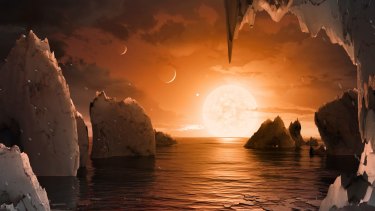
An artist'southward conception of the view from the 5th planet of the TRAPPIST-i system. Credit:NASA/JPL
Since the 1990s astronomers have detected hundreds of planets orbiting stars in our galaxy, including around the nearest star to the sunday, Proxima Centauri.
But this discovery of and then many terrestrial planets in our galactic neighbourhood is making people take find.
Charley Lineweaver from the Australian National Academy said: "Detections of World-similar planets in habitable zones are however quite rare, so this is meaning."
TRAPPIST-1, as the star is called, is an "ultracool dwarf" with a temperature of 2300 degrees (less than one-half that of the sunday), a radius slightly larger than Jupiter's and a mass but eight per cent that of the sun.

An creative person'due south impression of the TRAPPIST-1 planetary organisation based on available information nigh their diameters. Credit:NASA/JPL
"Past choosing such a minor star ways we volition exist able to study the climate and chemical composition of any planetary atmospheres," said 1 of the authors, Amaury Triaud from Cambridge University.
Astronomers cannot directly observe exoplanets just must deduce their beingness from the movement and light from their parent stars. Yet, they believe direct observation of planetary atmospheres will be possible within a decade.
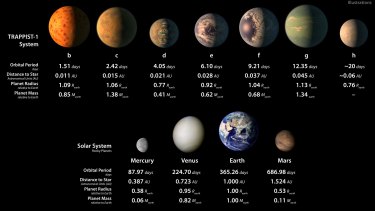
Top row: TRAPPIST-1 planetary orbital periods, distances from their star, radii and masses as compared to those of Globe. The bottom row shows data about Mercury, Venus, Globe and Mars. Credit:NASA/JPL
Chemical analysis of the atmospheres, if they exist, will help the states determine if these planets harbour life or are habitable.
Dr Gillon said the fourth, fifth and 6th planets "could have liquid h2o – and peradventure life – on their surfaces" assuming Globe-like atmospheres.
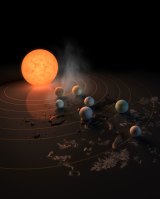
The TRAPPIST-1 star, an ultra-absurd dwarf, has seven Earth-sized planets orbiting it. This is the front cover image for this week'southward edition of Nature. Credit:Nature
The paper, published on Thursday in Nature, said the iii inner planets, if they have atmospheres, will likely have "delinquent greenhouse scenarios", like Venus.
Dwarf stars, while cool, are also very slow-burning and TRAPPIST-1 is simply a baby at 500 million years erstwhile.
Ignas Snellen, an astronomer at Leiden University in the Netherlands, writing in Nature said: "In a few billion years, when the lord's day has run out of fuel and the solar organisation has ceased to exist, TRAPPIST-1 volition nonetheless be only an babe star.
"It burns hydrogen so slowly that it volition live for another 10 trillion years, which is arguably enough time for life to evolve."
And possibly enough time for us to work out how to travel the 39 light years beyond interstellar infinite.
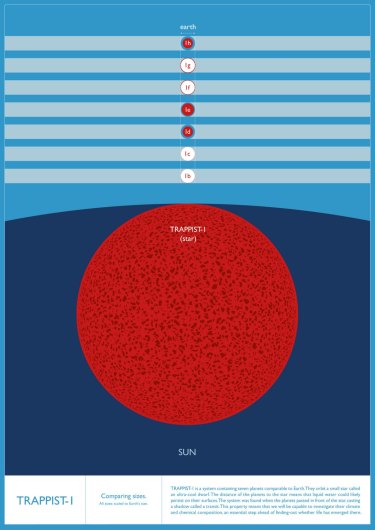
Graphic showing relative size of TRAPPIST-i to the sun and of its planets relative to Globe. Credit:Nature
Professor Chris Tinney from the University of NSW said the discovery was an exciting result.
"This is a new class of planetary system we didn't know nigh five years ago," he said. "A lot of our models about how planetary systems are formed are heavily biased towards explaining our solar system. This discovery could mean these meaty systems around smaller stars are really more common."
Dr Lineweaver said: "With TRAPPIST-i having then many rocky planets in and around the goldilocks zone, no affair how sceptical you are, one or more of the planets will lie in the goldilocks zone."
The goldilocks zone is a planet's altitude from a star where it's "not as well hot, not as well cold" for liquid water to form.
Yet, he said there were some important caveats when considering the discovery.
"Low-mass dwarfs take very long pre-primary sequence lifetimes during which the planets that are at present in the goldilocks zone could have lost all their water.
"What's the sense of saying that a planet is in the goldilocks zone if the planet lost all of its water billions of years earlier?"
The planets are as well likely tidally locked, which means the same face of the planet is always facing the star. The moon is tidally locked to the Earth.
Professor Tinney said tidally locked planets could have extremes of temperature betwixt the light and dark sides.
"Unless they have oceans and atmospheres to permit heat transference, the temperature differences could be extreme," he said.
The orbital periods of the planets are very short, ranging from 1.5 to 12.4 days, with masses ranging from 0.4 to ane.four times that of World.
Radiuses of the planets range from 0.8 to 1.1 Earths with planetary densities between 0.6 and 1.ii Earth densities.
TRAPPIST-i is named later the robotic telescope in Republic of chile used to first discover the system. The Transiting Planets and Planetesimals Small Telescope in the Atacama desert is operated by the University of Liege. Likewise every bit being the proper noun of an order of monks, trappist is the proper noun of a popular blazon of Belgian beer.
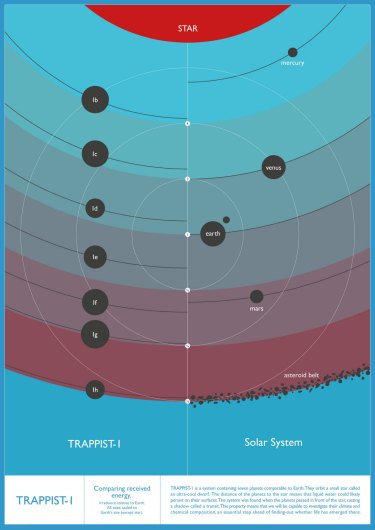
thousand. Credit:Nature
- Science
Near Viewed in Technology
Loading
How Many Earth Sized Planets Did Astronomers Discover Orbiting The Same Star?,
Source: https://www.smh.com.au/technology/seven-sisters-astronomers-find-star-system-with-multiple-earthlike-planets-just-12-parsecs-away-20170222-guidl3.html
Posted by: campbellsplad1984.blogspot.com


0 Response to "How Many Earth Sized Planets Did Astronomers Discover Orbiting The Same Star?"
Post a Comment